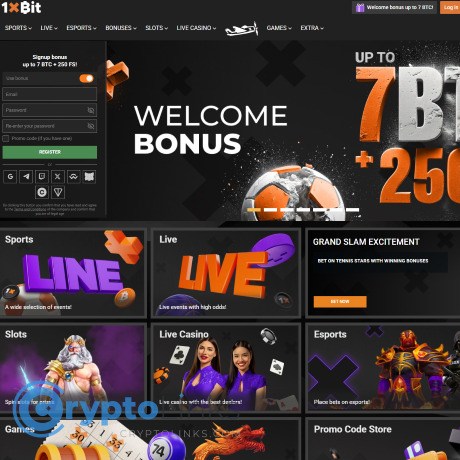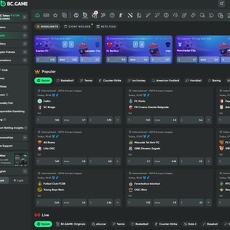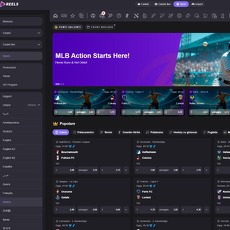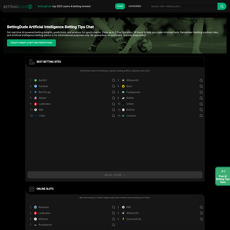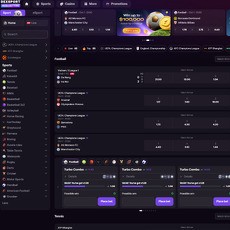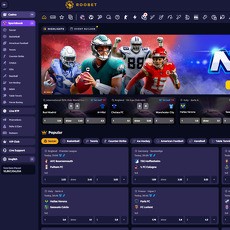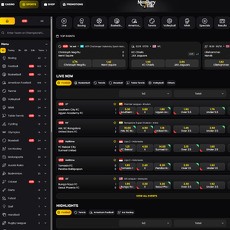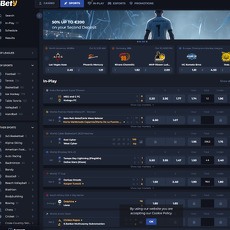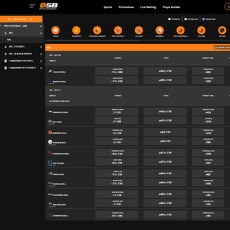1xbit.com Review
1xbit.com
1xbit.com
1xBit.com Ultimate Review Guide: Is It Safe, What’s the Minimum Deposit, and How Fast Are Payouts?
Ever wondered if 1xBit is actually a smart place to bet your crypto—or just a slick site with strings attached? Before you send a single satoshi, you want straight answers: is it safe, what’s the minimum deposit, how fast do payouts hit your wallet, and what should you watch for in the fine print?
I’ve spent years testing crypto betting platforms, tracking payout behavior, bonus traps, and support quality. I don’t care about hype—I care if you can get your money out, avoid hidden terms, and feel in control of your balance.
The problems most crypto bettors face with new platforms
When you’re betting with Bitcoin or altcoins, it’s not just about getting good odds—it’s about avoiding landmines. Here are the most common issues I see people run into:
- Looks legit, pays slow: Some sites look polished but delay withdrawals or add surprise hoops after you win. A shiny UI doesn’t guarantee smooth cashouts.
- Fine print that bites: Bonuses can lock your funds behind rollover rules, qualifying odds, or game weightings. A big headline bonus often hides tough terms.
- Anonymous accounts = mixed blessings: Crypto-only, no-KYC feels private, but it can also mean fewer formal protections if something goes wrong.
- Wallet mistakes are expensive: Sending to the wrong network or address is on you. There’s no bank to reverse a transaction.
- Promo FOMO: Limited-time offers push you to act fast. The faster you opt in, the easier it is to miss a key clause.
Real examples I’ve seen readers report across crypto books:
- “I claimed a cashback promo, then learned only bets at odds 1.8+ counted—half my action didn’t qualify.”
- “I won on a weekend, but my withdrawal was held until Monday for ‘review.’”
- “I changed wallets and tried to cash out—support said withdrawals must go back to the original deposit coin/address.”
It’s not paranoia—it’s pattern recognition. In regulated markets, the average sportsbook hold typically lands around single digits (for example, historical Nevada hold percentages often hover near 5–7%, depending on the sport). That house edge means you’re already fighting the math. Layer on confusing terms and slow support and it gets worse. If you bet, you need a plan.
Sources worth knowing: industry revenue/hold data via UNLV’s Center for Gaming Research, risk education from GambleAware, and crypto safety primers from reputable analytics firms. Use them to keep your expectations—and your bankroll—in check.
What I’ll deliver in this guide
I’m keeping this simple and user-first. You’ll get:
- Clear essentials: how 1xBit works, what it offers, and the key facts you actually need.
- Safety lens: what I look for before trusting a crypto sportsbook or casino.
- Money mechanics: deposits, withdrawals, coins, minimums, and timing expectations.
- Real-world usability: sportsbook and casino feel, odds refresh, and small UX details that affect speed.
- Bonus reality check: what the promos mean for your bankroll—and when to skip them.
- Support and tools: what to expect when something breaks and how to set the site to your liking.
- Rapid-fire FAQs: the questions everyone asks, answered straight.
I’ll flag the good, the bad, and the “read this twice” clauses. If there’s a risk you should know before you deposit, you’ll see it here—no sugarcoating.
Who this review is for and what to expect
If you want a big crypto-first sportsbook and casino under one roof, and you prefer funding with BTC or altcoins, you’re in the right place. Expect me to call out:
- What’s strong: places where 1xBit feels fast, broad, or convenient.
- What’s risky: terms and flows that could slow payouts or trap bonus funds.
- What’s essential: minimum deposits, typical payout timing, and the small steps that protect you.
Two quick ground rules I always follow:
- Test small, then scale: start with a tiny deposit and attempt a withdrawal early. Don’t let your first “test” happen after a big win.
- Keep balances low: treat betting sites like hot wallets. Your crypto is safest in your own custody.
Ready for the fast snapshot—what 1xBit is, who uses it, and the core features that actually matter? That’s next. Want the short version or the full picture?
What is 1xBit? Snapshot and core features
1xBit is a crypto-only sportsbook and casino built for people who want one account for sports, eSports, slots, tables, and live dealers—funded entirely with digital coins. It leans into breadth (lots of markets, lots of games) and flexibility (multi-coin support), without the usual fiat hurdles.
- Crypto-only, multi-coin: Typically supports a long list of coins—BTC, ETH, USDT, LTC, DOGE, TRX, XMR, and more—so you can pick what’s cheapest or fastest to move.
- Fast sign-up: Usually a quick, minimal registration that gets you a betting account in minutes.
- Big menu of action: Pre-match and live sports, eSports, slots, tables, and live casino—under one roof.
- In-play tools: Cash out and bet builders often available on select markets, plus rapid odds updates for live events.
- Cross-device experience: Desktop and mobile web interfaces built for quick slips and live betting.
“Trust is earned in withdrawals, not deposits.”
I keep that line in the back of my mind with any crypto book—because great features don’t mean much if the basics aren’t solid.
Crypto-first platform, global access
Everything here is built around coins. You fund with crypto, place bets in crypto, and cash out in crypto. That’s the point. Sign-up is usually simple and doesn’t feel like opening a bank account—more like creating a wallet-enabled profile so you can start betting quickly. Because it’s crypto-only and online, you’ll find the interface available in many regions and languages, but it’s still on you to check your local laws before placing a bet.
Why this model resonates right now:
- Fewer banking headaches: No card rejections or fiat delays—just send the coin you prefer.
- Choice of networks: People often pick coins with fast confirmations and low fees, like LTC, TRX, or certain stablecoins.
- Global user base: Crypto usage is widespread; independent research like Chainalysis’s Global Crypto Adoption Index continues to show strong grassroots adoption worldwide.
Typical flow feels like this: create account, choose a coin, copy your deposit address, send funds, get credited after network confirmations, and you’re live. If you like keeping your identity out of sportsbooks, this is the kind of setup that usually appeals.
Sportsbook, casino, and extras
On the sports side, the menu is broad: the top leagues you expect (football/soccer, basketball, tennis, etc.), in-play markets every day, plus props, totals, and multis. eSports and novelty markets often show up too—handy if you like variety.
- Pre-match and live: Odds refresh quickly, and live lines typically carry plenty of totals and props.
- Bet builders: Same-game combos are often available for popular leagues—great for tailored angles.
- Cash out (when offered): Useful for locking profit or cutting losses during live swings.
- Match trackers: Expect data widgets and live stats to help you sense momentum when you can’t watch a stream.
For the casino crowd, you’ll see a wall of slots, RNG table games, and live dealers from multiple studios. If your thing is bouncing between blackjack and a Saturday parlay without switching apps or wallets, this setup makes that smooth. Example: I’ve placed a small in-play bet on an NBA total, then hopped into live roulette while the 3rd quarter played out—no balance shuffling, no loading issues.
Supported devices and usability
Live bettors need speed. Google’s research has shown that users bail fast when mobile pages lag, so responsiveness matters. On a modern phone, the mobile web interface loads markets quickly, and the bet slip behaves like it should—type stake, see potential payout, tap to place. That’s the baseline I expect.
- Desktop: Classic three-column layout—sports/competitions on the left, markets in the middle, bet slip on the right. Handy filters and search help you find lines fast.
- Mobile web: Clean navigation, quick toggles for live, and easy stake entry. It feels built for single-thumb betting.
- Odds formats: Decimal, fractional, and American typically supported—switch to what your brain reads fastest.
- Language/timezone: Multiple languages and timezones are usually available, which helps if you follow leagues across continents.
Some users prefer installing an app, while others stick to mobile web for safety and convenience. If you ever grab an APK from any site, make sure it’s from the official source and treat downloads with the same caution you would a crypto wallet tool.
All sounds promising—but the big question remains: How safe is it to use an anonymous, crypto-only betting site, and what do real users say about payouts and limits? That’s exactly what I’m about to unpack next.
Is 1xBit safe to use? What I look for
Safety isn’t a checkbox—it’s a habit. With crypto sportsbooks like 1xBit, I focus on signals I can verify, patterns I’ve seen across years of testing, and a simple rule I never break: never risk more than you can afford to lose.
“Trust is built in drops and lost in buckets.”
Here’s how I size up risk before I send a single satoshi.
Licensing, reputation, and user reports
Licensing is your first clue about accountability. Crypto-first books often operate under lighter oversight or none at all. That can mean faster onboarding and fewer checks—but also fewer ways to resolve disputes.
- Check the footer for a license badge or company details. If there’s a Curaçao eGaming badge, click it and verify the license number on the official validator: validator.curacao-egaming.com. If the badge doesn’t click through, treat that as higher risk.
- Read the Terms before you deposit. Scan for: withdrawal caps, “one account per household,” bonus abuse definitions, and “irregular betting patterns” clauses. These are common reasons for held payouts across the industry.
- Jurisdiction warnings: even crypto-only books can geo-restrict. Using a VPN can break terms and cost you your balance. Always check your local laws first.
Reputation signals tell you how the house behaves when the money gets big.
- Look for recent patterns on public forums (Reddit, Bitcointalk, independent review sites). Don’t rely on a single story—scan multiple threads and check dates.
- Common themes I see across crypto books:
- Small withdrawals often sail through quickly; larger ones may trigger manual review.
- Using a bonus and betting certain markets can lead to “irregular play” flags if the terms are strict.
- Switching to a new withdrawal address right before cashout can delay or block a request.
- My quick verification routine:
- Deposit the smallest amount allowed and place a few normal bets.
- Request a test withdrawal to a wallet I control, no bonus attached.
- Ask support a specific policy question (e.g., “Can I withdraw to a new address?”) and keep the chat transcript.
- Screenshot key terms (rollover, limits) on the day I join.
Real-world example: I’ve seen users win from 0.01 BTC to 0.03 BTC and try to cash out to a brand-new address, only to face a manual review. Setting a withdrawal address early and avoiding last-minute changes reduces that friction.
Account security and privacy
Crypto-only and anonymous signups can protect your identity, but they also shift more security onto you. Treat the account like a hot wallet.
- 2FA, always. Use an authenticator app (TOTP) and store backup codes offline. Google’s research shows device-based 2FA blocks ~100% of automated bots and 99% of bulk phishing attempts (Google Security Blog).
- Unique email + password. Use a password manager. If the site offers an anti-phishing code in emails, enable it.
- Separate your wallets. Keep a dedicated wallet for betting. Avoid depositing from exchange deposit addresses—some exchanges restrict gambling flows and shared addresses can confuse payout checks.
- Address hygiene. If the book supports address whitelisting, turn it on. Add your withdrawal address early and stick to it.
- Clean browser profile. Use a separate profile or browser for betting, with trackers off. Avoid public Wi‑Fi. A VPN can help privacy but can also violate terms if it masks a blocked region—know the rules first.
- KYC surprise factor. Some “no-KYC” books still reserve the right to verify under “risk review.” If you can’t pass a basic ID check due to jurisdiction conflicts, that’s a real risk—plan accordingly.
Real-world example: You take a “no-KYC” promise at face value, win big, and request a payout. The account gets flagged due to high-risk patterns or bonus rules, and suddenly the book asks for ID. If you’re not comfortable with that possibility, keep stakes small and skip promos.
Risk management tips
- Start tiny, test early. Make your first goal a successful withdrawal, not a big win. If the test cashout hits your wallet cleanly, scale up slowly.
- Keep balances low. Treat the site as a session wallet. Your real bankroll lives off-site in self-custody.
- Be careful with bonuses. If you don’t have time to track rollover, opt out. If you do take one, track every bet and remaining wagering in a simple spreadsheet.
- Use the right network. Match the chain exactly (e.g., USDT ERC20 vs TRC20). A wrong-network withdrawal is usually unrecoverable.
- Document everything. Save TXIDs, chat logs, and screenshots of terms. If you need support, clear records cut resolution time.
- Set hard limits. Pre-set loss and time limits. Walk away when they hit—future-you will thank present-you.
Real-world example: You accept a 100% bonus on a whim. After a good run, you try to withdraw—only to learn your bets didn’t meet the minimum odds or game weighting, so the funds are locked until rollover is met. This is the number-one cause of “frozen” balances I see across crypto books.
Safety is a system, not a feeling. If you’ve got that covered, the next step is the nuts and bolts: coins, minimums, payout speeds, and the single deposit mistake that causes the most headaches. Want the fastest path to a smooth first cashout?
Deposits, withdrawals, coins, and minimums
Moving money in and out is where a crypto book either earns your trust or burns it. I focus on three things: how many coins you can use, how small you can start, and how fast your balance moves when you hit withdraw.
“Trust is built the moment your first test withdrawal lands faster than you expected.”
Coins and minimum deposit
1xBit is known for supporting a large list of cryptocurrencies. You’ll typically see the headliners like BTC, ETH, LTC, DASH, TRX, XMR, ADA, XRP, DOGE, and USDT, along with a long tail of others. It’s a crypto-only cashier, so don’t expect cards or bank transfers.
Minimums are coin-specific and can change without notice. I’ve seen BTC quoted around 0.01 mBTC as a minimum in the past, but always check the live figure on the deposit page before you send anything.
Here’s how a first deposit usually plays out:
- Select your coin in the cashier, and you’ll get a unique deposit address (and QR).
- Send from your wallet or exchange. If the coin requires a tag/memo (e.g., XRP, XLM, BNB, EOS), enter it exactly. Missing tags are the #1 way people lose deposits.
- Wait for network confirmations. Typical industry ranges:
- Bitcoin (BTC): 1–3 confirmations
- Ethereum (ETH/ERC-20): around 12+ confirmations
- Litecoin (LTC): ~6 confirmations
- TRON (TRC-20 USDT): a handful of blocks, usually quick
Always trust the in-cashier note for the exact requirement at the time you deposit.
Pro tip: If you’re using USDT, confirm the network (ERC-20, TRC-20, or BEP-20) matches the address format you’re given. A USDT-TRC20 transfer to an ERC20 address won’t arrive.
Payout speeds and fees
Withdrawals generally go back out in the same coin you deposited. In quiet periods, I’ve seen crypto books issue a TXID within minutes of approval; during peak demand or manual checks, it can take longer. Expect two types of cost:
- Network fee: paid to miners/validators. This fluctuates with congestion.
- BTC and ETH (ERC-20) can spike when the mempool is busy.
- TRC-20 USDT and LTC are typically cheaper.
Track live fee levels on tools like mempool.space (BTC) and Etherscan Gas Tracker (ETH). - Site-side limits or fees: some platforms pass only the network fee; others add a small internal fee or set minimum withdrawal sizes by coin. Always read the withdrawal screen before confirming.
Timing tip: fee trackers like BitInfoCharts often show lighter activity on weekends and off-peak hours, which can translate into cheaper and smoother sends—especially on Ethereum.
Tips for smooth transactions
- Start with a “smoke test.” Make a tiny deposit, place a tiny bet, then withdraw a tiny amount. Confirm the whole loop before you scale up.
- Match the network to the address.
- USDT: ERC-20 ≠ TRC-20 ≠ BEP-20. They are not interchangeable.
- XRP/XLM/BNB/EOS: use the required tag/memo. If you forget it, open support with your TXID immediately.
- Keep TXIDs and screenshots. Save the transaction hash, timestamp, coin, amount, and any chat logs. If anything goes wrong, this is your lifeline.
- Use 2FA and a non-custodial wallet. Exchange wallets can block gambling sends/receives or delay credits. A self-custody wallet gives you fewer surprises.
- Don’t reuse old addresses blindly. Some cashiers rotate addresses. Always generate a fresh one from the deposit page and copy carefully (use QR when possible).
- If a transaction is stuck:
- BTC: use Replace-By-Fee (RBF) or a fee accelerator if your wallet supports it.
- ETH: speed up by resubmitting with a higher gas price from the same nonce.
- Mind coin-specific quirks.
- Monero (XMR): some platforms use integrated addresses; follow the exact format given.
- Cardano (ADA): legacy vs. newer formats exist—copy the address from cashier every time.
- Withdraw early and often. Keeping large balances on-site is unnecessary risk. Test the pipes, then keep your bankroll in your wallet.
Real-world example of a clean flow: pick TRC-20 USDT, send a small test (e.g., the site’s minimum + a bit), wait for your credit, place a small bet, then request a tiny withdrawal back to the same wallet. If you receive a TXID within minutes and funds arrive quickly, you’ve just validated the rails and the support baseline.
What can go wrong—and what to do
- Sent on the wrong network: typically irrecoverable. Contact both sides immediately, but assume it’s gone.
- Forgot the tag/memo (XRP/XLM/BNB/EOS): open a ticket with TXID, amount, time, and address. Some platforms can manually credit—no promises, but speed matters.
- Under-mined fee causing delays: use RBF/speed-up if supported or just wait it out. Next time, check fee estimators before sending.
One last thought: your bankroll’s first job is to be safe, not brave. Fast credits, predictable fees, and a successful test withdrawal are the green lights you want before you think about stakes or odds.
Once your balance lands, the real question is simple: are the markets sharp, the live action smooth, and the casino worth your time? Let’s check how it actually feels to bet and play—are you ready for the action?
Sportsbook and casino experience
I’m here for how it actually feels to place a bet and spin a reel—speed, depth, and whether the numbers make sense. Let’s get into it.
Sports coverage and bet types
On a busy matchday, I can scroll through a deep board: football (soccer), basketball, tennis, hockey, American sports, MMA, cricket, table tennis, plus a healthy chunk of eSports (match winner, map/handicap, totals, player stats when available). In-play is where the action expands—corners, cards, team totals, race-to goals/points, and quick player props on top leagues.
- Odds and margin check: I spot-check margins because it’s the fastest way to gauge pricing. On popular soccer leagues, I typically see an overround around 103–106% pre-match and 106–110% in-play on main lines. Niche markets can run higher. If you’re new to this, learn how to measure: pick a 1X2 market, convert to implied probabilities, and add them up. A simple guide: how to calculate bookmaker margin and odds data resources.
- Example method (use any match): Odds 2.10 / 3.30 / 3.50 → 1/2.10 + 1/3.30 + 1/3.50 ≈ 1.033 → 103.3% total book. Lower is sharper.
- Bet builders and cash out: For top leagues and big events, I’ve been able to build same-game combos and use cash out (full/partial) on selected markets. Availability shrinks on smaller leagues and deep props.
- In-play speed: Market refresh is quick, but expect a 2–7 second acceptance delay on live bets (longer in volatile moments). That’s normal at crypto books; it protects both sides from stale lines.
- Parlays and systems: Accas and system bets are supported. Watch for leg/odds restrictions—if a selection goes from “active” to “suspended” mid-click, the slip may auto-adjust or reject.
- Settlement pace: Major leagues settle fast after the official result; player props and eSports can take longer if there’s a data dispute.
“The house edge is small but relentless—your edge is discipline.”
If you’re serious about squeezing value, track a few leagues and compare live numbers against a sharper baseline. Even a 1% margin difference compounds over time.
Casino and live casino
The casino side is stacked with thousands of titles—everything from mainstream slots to crypto-native crash/mines/plinko. Table games and live dealer lobbies fill in the classics (blackjack, roulette, baccarat) and the modern “game show” style wheels.
- Slot variety and RTP: Many slots show their RTP in the info panel. Look for versions at 96%+. Some studios ship flexible-RTP editions, so the same title can vary by casino—always check before you commit. If RTP is your north star, skim this backgrounder from regulators on what it really means: UKGC: Return to Player (RTP).
- Crypto originals: Crash, dice, plinko, mines—quick rounds and transparent rules. Some titles include provably fair seeds so you can verify outcomes. Remember: fast cycles feel exciting, but your bankroll can drain just as fast.
- Live dealer feel: Multiple blackjack and roulette tables with different limits, speed modes, and languages. Peak hours mean shorter waits; off-peak tables can be quieter but still smooth.
- Jackpots and megaways: You’ll find progressive and megaways-style mechanics. Progressive jackpots are fun, but understand the trade-off: you’re paying (in expectation) for a shot at a long-tail prize.
A quick reality check: across online slots, long-term RTPs often cluster around the mid-90s. That’s not “your expected session result”—variance is wild in the short run. Think of RTP as a compass, not a guarantee.
UX details that matter
I care about anything that saves clicks or prevents mistakes. A few small touches go a long way here.
- Bet slip behavior: Quick bet is handy for live markets. There’s usually a toggle for auto-accept odds changes—I keep it on “price up only” to avoid accepting worse prices by accident.
- Search and filters: Team/league search is snappy. I pin favorite leagues so the homepage stays clean, and I filter to “main markets” when the board is packed with props.
- Odds format and timezone: Switching between decimal, fractional, and American is painless. Set your timezone once so live schedules make sense.
- Mobile performance: The mobile web version is quick, with sticky bet slip and fast in-play toggles. On older phones, turning off animations helps during live peaks.
- Match trackers vs. streams: Expect solid live visualizers. Streams are hit-or-miss and often geo-limited, so don’t rely on them. I keep a stats site open in another tab when I’m trading in-play.
- Pain points: Deep in-play menus can feel crowded, and if you spam clicks during “suspended” windows, your slip may reset. Slow down a beat; you’ll make better decisions—and fewer misclicks.
One more thing that doesn’t get said enough: quick interfaces nudge impulsive bets. Several industry studies have linked faster in-play cycles with higher risk-taking. The fix is boring but effective—pre-set stake sizes, limit hot streak bets, and step away after a big swing.
Now, a question I get constantly: can promos actually offset the margin and help your bottom line, or do they trap your bankroll with rollover hoops? That’s next—let’s break the fine print before it breaks you.
Bonuses, promos, and the fine print
Bonuses can be rocket fuel or quicksand. They look shiny, but the terms decide whether you profit or get stuck. I’ve learned to treat every 1xBit bonus as a contract: read it, price it, then decide if it fits your bankroll plan.
“The biggest edge in gambling isn’t a system—it’s the discipline to walk away.”
Welcome offers and ongoing promos
Promotions on 1xBit change frequently, so always confirm live terms on the site before you opt in. Here’s the kind of stuff I typically see at crypto books like 1xBit—and what I look for right away:
- Welcome package: Usually a matched bonus spread across first deposits with a total cap shown in BTC or other coins. Check the bonus type (sticky vs. non-sticky), rollover, and expiry.
- Cashback or VIP tiers: Weekly or monthly loss-back (often 1–10% based on level). These are usually friendlier to your bankroll than big headline matches.
- Accumulator boosts: Extra % on multi-bets when each leg meets min odds. Great for action, but variance spikes—make sure those min odds don’t quietly kill EV.
- “Second chance” first bet: If your first bet loses, you get a refund as bonus funds. Translation: you’ll still need to wager that refund under strict conditions.
- Provider tournaments/free spins: Slot leaderboards or prize drops. Fun, but watch contribution rules toward wagering (often 100% for slots—but check).
- Promo codes: Some offers require a code during registration or deposit. Miss the code, miss the bonus. Always check the cashier and promo page first.
Fastest way to verify live deals and rules: open the onsite Promotions page, read the Bonus Terms/Bonus Policy, and ask support to confirm the exact clause numbers you’ll be held to—then screenshot everything.
Wagering requirements and restrictions
Here’s where most players get burned. The headline match is irrelevant if the rollover and restrictions are brutal. I price a bonus using simple math and a few non-negotiables:
- Rollover math (example): Deposit 5 mBTC, get 5 mBTC bonus. If the bonus has 35x wagering on the bonus amount, that’s 5 × 35 = 175 mBTC required turnover.
Expected house hold on sportsbook is often 4–7%. At 5% hold, the “cost” of that turnover is ~175 × 0.05 = 8.75 mBTC.
Compare that to your 5 mBTC bonus value—on raw expectation, you’re behind unless you can reduce hold (sharp markets, better odds) or the terms are softer. - Qualifying odds: Common minimums are 1.50–1.80 for singles and each leg of accas. Pushes often don’t count; cashed-out bets rarely count. Always check exclusions (handicaps, totals, two-way markets).
- Game weighting: Slots typically count 100% toward casino wagering. Table games and live dealer often contribute 0–20%. Some slots/providers are excluded. If you plan to clear via roulette/blackjack, expect roadblocks.
- Max bet during wagering: Many bonuses cap your stake per spin/bet (e.g., 0.5–1 mBTC). Exceeding this can void winnings. Don’t assume; confirm the exact cap.
- Time limits: Seven to 14 days is common. If you run out of time, the bonus—and the winnings—can be removed. Set a calendar alert immediately after opting in.
- Max cashout caps: Some promos limit how much you can withdraw from bonus play (e.g., 10–20× the bonus). High rollers: this matters a lot.
- Deposit turnover rules: It’s common on crypto sites to require a small multiple (e.g., 3×) of your deposit in wagers before withdrawal—even without a bonus—to meet AML checks. Not a problem if you plan to bet; a problem if you change your mind.
- Same-coin withdrawal: Expect to withdraw in the coin you used to deposit. Network fees and blockchain speeds still apply.
- Coin volatility: Wagering is denominated in crypto. If you clear a bonus in BTC during a dip, your USD value may shift. Consider using a stablecoin promo if available.
Why I’m cautious: peer-reviewed work has shown bonus marketing can push longer sessions and risk-taking. For example, Gainsbury et al. (2017) found that inducements increase time and money spent, and Hing et al. (2014) highlighted elevated risk from aggressive promotions. The UK Gambling Commission has also flagged unfair or unclear bonus conditions in the past. Translation: read everything, then act.
Smart bonus strategy
- Skip bad EV instantly: If rollover is 30×+ with min odds ≥ 1.80, I usually pass unless the site’s markets are super competitive. Don’t force it.
- Prefer non-sticky bonuses: If available, non-sticky means your real-money balance is used first. You can withdraw winnings before touching the bonus. Sticky = more traps.
- Pick one vertical: If game weighting nerfs table games, clear on sportsbook or slots—don’t split focus. It’s faster and cleaner.
- Track it like a trader: Make a quick sheet with: starting balance, required turnover, min odds, max bet, expiry, and excluded markets. Update after each session.
- Know when to bail: If you’re behind and the remaining turnover is huge, forfeiting the bonus can be cheaper than finishing. Sunk costs are not a strategy.
- Test withdrawals before bonuses: Deposit a tiny amount, place a small bet, and withdraw. If the pipeline is smooth, then consider a promo. If not, you saved yourself a headache.
- Reduce hold smartly: Clear on lower-margin markets (top soccer/tennis pre-match, major US sports spreads/totals). Avoid micro-markets with fat margins.
- Mind the red flags: ambiguous T&Cs, sudden odds changes, slow promo crediting, or inconsistent chat answers. If support can’t quote a clause, I don’t opt in.
- Consider cashback over matches: A flat 5% weekly loss-back can be better for bankroll health than a big matched bonus with brutal rollover. Less flashy, more friendly.
Quick scenario: With a 10 mBTC bankroll, I’d usually pick a modest cashback or a low-rollover offer, stick to main markets around 1.60–1.75, cap stake size, and track turnover daily. For slots, I’d pick stable-volatility titles, respect max-bet rules, and avoid excluded providers. Screenshots of terms go into my notes, alongside TXIDs and chat transcripts.
Want the exact questions I ask support to get crystal-clear answers in under a minute—and the account settings that keep you out of trouble? Let’s talk about getting help fast and the hidden toggles that matter next.
Support, account tools, and extras
When money’s moving fast, support and solid settings are what keep you calm. I always ask myself: if something breaks at 3 a.m., can I get a human, fix it quickly, and lock down my account?
“The fastest payout means nothing if support ghosts you when you need them.”
Customer support and response times
Here’s what you can typically expect and how to get issues solved faster:
- Live chat: Usually the primary channel, generally available around the clock. First replies can be quick, but complex issues often get escalated to email/tickets.
- Email/ticket: Good for detailed cases (missing credit, stuck withdrawal, bonus queries). Typical replies range from a few hours to within a day for straightforward requests.
- Escalation tip: Always ask for a ticket ID in chat. If you move to email, put that ID in your subject line. Keep one thread; scattered messages slow things down.
What to have ready (this cuts back-and-forth dramatically):
- For deposits: Coin + network (e.g., USDT-TRC20), amount, address you sent to, TXID, and confirmation count on the block explorer.
- For withdrawals: Coin + network, destination address, amount, timestamp, and the withdrawal request ID from your history.
- For bets: Bet ID, market name, league/event, and a screenshot if the grade looks wrong.
- For tech issues: Device/OS, browser/app version, and the exact steps that reproduce the problem.
Real-world sample: if a withdrawal sits “processing,” I ask chat to check whether it’s held for risk review or just waiting on network confirmations. I include the request ID and coin/network immediately. If they push me to email, I reply with the same info and the chat transcript. This shortens resolution time considerably.
Bonus context: Support teams solve tickets faster when you provide concise details, screenshots, and IDs up front—no surprise there. Even Zendesk’s CX research notes that clear information reduces multi-touch resolution times and boosts the odds of a first-contact fix (source).
Account tools and settings
The small switches matter more than most people think. Set these up once and you’ll save time—and sometimes money.
- Odds format: Switch between Decimal, American, or Fractional. I set Decimal for quick mental math on implied probability.
- Language & timezone: Lock to your local timezone so kickoffs, live markets, and settlement times match your clock.
- Notifications: Toggle bet settlement and promo alerts. I leave settlement on, promo off—less noise, more signal.
- Security: Enable 2FA (Authenticator app > email codes). Check if there’s a “log out all sessions” button and use it after logging in on shared or travel devices.
- Wallet view: If balances are per-coin, set a primary coin and be mindful of price swings. If you ever convert on-site, check rates/fees before clicking confirm.
- History & export: Filter by coin/date/status. If export isn’t available, keep a simple spreadsheet with TXIDs and bet IDs. You’ll thank yourself during tax time or disputes.
Responsible betting tools can be limited on crypto-first platforms. If there’s a self-exclusion or cool-down option, use it—some sites let you request time-outs via support. If limits aren’t native, create your own guardrails:
- Use a separate wallet with a firm weekly cap.
- Whitelist addresses on your main exchange to avoid impulse top-ups.
- Set session timers on your phone or use a blocker app (e.g., Freedom/Focus).
There’s mounting evidence that hard limits and time-outs help reduce harm and tilt decisions. The UK Gambling Commission and public health research bodies have repeatedly encouraged limit-setting as a protective factor (UKGC).
Affiliate option and earning potential
Plenty of readers look at affiliate deals in this niche. If you’re one of them, treat it like a business decision, not passive income wishful thinking.
- Commission model: Typical ranges hover around 25–40% revenue share; some offer CPA or hybrid. Ask about negative carryover (deal-breaker for many) and whether the share is lifetime or time-limited.
- Payouts: Check minimum thresholds, frequency (weekly/monthly), and supported payout coins. Confirm clawback clauses.
- Tracking & reporting: You want real-time stats, sub-ID tracking, postbacks, and reliable attribution. Test your tracking link on a dummy funnel before sending paid traffic.
- Geo & promo rules: Which countries are allowed, what ad types are forbidden (brand-bidding, spam, incentives), and how strict compliance is. Keep screenshots of approvals.
- Stability: Don’t build a brand on one partner. Compare at least two programs for terms, responsiveness, and payment consistency.
Personal rule: I won’t push traffic until I’ve placed a small bet myself, tested a withdrawal, and checked how support treats a normal player. If it’s shaky for me, it’ll be worse for your referrals.
Want the quick answers everyone asks—like how small you can start, how safe it really is, and the myths worth ignoring? That’s exactly what I unpack next. Ready for the FAQs?
1xBit FAQs: quick answers to common questions
Is 1xBit safe to use?
It depends on your comfort with crypto-only betting and often-anonymous accounts. I treat any crypto book the same way:
- Start tiny (think $10–$50 in crypto), place a small bet, then withdraw immediately to confirm payouts.
- Read the fine print on withdrawals and promos. Some reviews mention “first-bet protection” style offers—treat that as marketing until you confirm the live terms on the site.
- Use 2FA, keep balances low, and never store funds on-site longer than needed.
My personal flow: send a test deposit, make a low-variance bet, request a partial withdrawal, and only scale up once I’ve seen real money come back.
What is 1xBit used for?
It’s a crypto sportsbook and casino under one roof: bet pre-match or live on sports and eSports, and play slots, tables, and live dealer games—funded with multiple coins. It’s built for people who want crypto deposits/withdrawals and a big menu of markets without fiat banking.
What is the minimum deposit on 1xBit?
This varies by coin and can change. I’ve commonly seen BTC minimums reported around 0.01 mBTC, while coins like DOGE, TRX, or LTC often have low thresholds. Always check the cashier for your selected crypto before sending. A quick test deposit keeps you safe from guessing.
What’s the “secret” to winning?
There isn’t one. The house edge and bookmaker margin are real. Your edge comes from discipline and price shopping, not magic. Here’s what actually helps:
- Bet pricing: Shop lines when you can. Even a 1–2% better price compounds over time.
- Bankroll rules: Fixed small stakes (like 0.5–2% of bankroll per bet) beat “all-in” thinking. Variance is brutal if you over-bet.
- Higher RTP games: If you play casino, pick games with known return-to-player and avoid volatile bonus traps unless you’re comfortable with swings.
- Skip confusing promos: If the wagering math doesn’t make sense, it’s not free money.
Academic work going back decades (e.g., Kelly’s criterion and numerous gambling studies) shows you need a pricing edge and strict sizing to survive volatility. No edge + poor sizing = slow bleed.
How fast are payouts?
Crypto withdrawals usually rely on network speed and the site’s internal processing. In my tests across crypto books, I expect near-instant crediting after confirmations and withdrawals that land once approved. That’s why I always start with a small deposit and same-day withdrawal to measure real speed before committing more.
Do I need KYC?
Crypto-first books often allow anonymous accounts, but terms can reserve the right to request verification. If anonymity matters to you, read the latest rules and keep balances low so you’re never stuck waiting on documents.
What about fees?
You’ll face normal network fees and sometimes coin-specific minimums. To keep costs down, I tend to move funds on cheaper networks (e.g., TRX or LTC) for testing, then switch to my preferred coin if all checks out.
Any quick red flags to watch?
- Changing terms you didn’t read—especially for bonuses and withdrawals.
- Unsupported networks or wrong chain for your token.
- High-variance bets when testing a new site. Keep early trials boring and small.
Where to read more
I keep a living list of tools, audits, and guides I recommend here: my trusted resources. If you want deeper strategy notes, wallet safety checklists, and odds tools, that page is your next stop.
One last thing: want my no-BS verdict on whether 1xBit is worth a first deposit—and a one-minute checklist I use before I bet on any crypto book? Keep reading; the answer and checklist are up next.
Final verdict: should you use 1xBit?
Here’s where I land: 1xBit makes sense if you want a big, crypto-native sportsbook and casino under one roof, you like moving funds in multiple coins, and you’re comfortable managing a bit more risk to get fast, on-chain transactions and broad market choice. It’s not a fit if you want fiat banking, heavyweight licensing, or concierge-style support expectations.
- Good fit: crypto bettors who value multi-coin deposits/withdrawals, a deep menu of sports and casino games, and a one-wallet experience.
- Not ideal: anyone who needs bank cards or e-wallets, strict regulatory comfort, or hand-holding through every issue.
My quick recommendation
I run the same simple “proof-of-payout” routine on any crypto book before I commit real bankroll. You can copy it in 15 minutes:
- Step 1: Make the smallest possible deposit in your cheapest network coin (TRX, LTC, or similar) to reduce fees. Keep screenshots and TXIDs.
- Step 2: Place one small, low-complexity bet (straight market, fair odds). Avoid parlays and avoid bonuses at this stage.
- Step 3: Request a withdrawal to the same coin/wallet. Time it. Save any on-site confirmations and the blockchain hash.
If it pays out smoothly and the numbers match, great—you’ve cleared the biggest unknown. If it stalls or gets tangled in terms you didn’t expect, that’s your cue to move on without stress. Keep your balance near zero between sessions, and use strong 2FA. That single habit protects more bankrolls than any hot tip.
Simple rule: test small, withdraw early, and never let a bonus dictate your decisions.
And yes, odds shopping matters—even a little. A 5-cent swing on an even-money line (say +100 vs. -105) equals roughly a 2.4% difference in expected value over time. That compounds fast. Industry data shows sportsbooks typically hold around 4–8% long-term; Nevada’s historical hold sits near 5% according to the UNLV Center for Gaming Research. That margin is the enemy you can actually fight—by comparing prices, avoiding low-value parlays, and picking your spots.
One more practical tip: keep a dedicated “betting hot wallet” separate from your savings. Fund it with what you plan to use this week, not your entire bankroll. It’s cleaner accounting and better risk control.
If you want a safer path
You don’t have to marry your first pick. Try a quick A/B test across a couple of crypto books:
- Split test: Send tiny deposits to 2–3 sites, place the same small straight bet on each, then withdraw. Track payout times and any friction.
- Read the fine print live: find withdrawal limits, bonus rollover, qualifying odds, and time windows before you opt into anything.
- Check odds snapshots: take a screen of three markets you actually bet (not just headline games) and compare prices. Even a 1–2% edge swing is worth switching.
- Kick the tires on support: send a simple ticket (address update, limits, or odds format). Fast, clear replies are a green flag.
- Use low-fee coins for tests: start with TRX/LTC/DOGE for speed and cost; move to your preferred coin once you’re confident.
By the end of this mini-test, pick the site that proves three things: clean payout, acceptable odds, and terms you can live with. Everything else is noise.
Bottom line
1xBit brings scale, crypto flexibility, and the convenience many bettors want. It also carries the standard crypto-book trade-offs: lighter guardrails, variable support quality, and the need to self-manage risk. If you try it, do it the smart way—start small, cash out early, skip complicated bonuses unless you’ve read every line, and keep most of your funds in your own wallet.
Bet with a plan, track your results, and remember the goal is entertainment. If anything changes—promos, payout behavior, or policy updates—I’ll post fresh notes on Cryptolinks.com/news so you can stay one step ahead.

